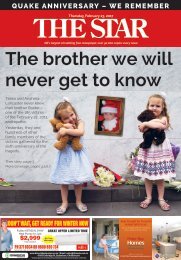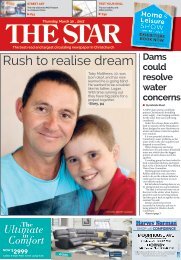Review of the Tsunami Evacuation 2017
You also want an ePaper? Increase the reach of your titles
YUMPU automatically turns print PDFs into web optimized ePapers that Google loves.
Never<strong>the</strong>less, when a local tsunami threat is detected, MCDEM will issue warning messages for<br />
New Zealand via <strong>the</strong> National Warning System, recognising that <strong>the</strong>se messages will likely arrive<br />
after tsunami waves arrive in <strong>the</strong> closest locations to <strong>the</strong> earthquake. MCDEM reviews its<br />
processes and responses after every activation and have recognised that <strong>the</strong> first messages for<br />
this event could have been clearer. The review document for MCDEM’s response will be provided<br />
to all CDEM Groups and publicly released in April <strong>2017</strong>. There are several operational actions and<br />
message templates that have been updated as a result <strong>of</strong> this event, (combined with <strong>the</strong> review <strong>of</strong><br />
<strong>the</strong> East Cape earthquake and tsunami <strong>of</strong> Sep 2 2016).<br />
1 Cover page Report Title As this was a multi-region event make clear <strong>the</strong> review is for Canterbury evacuation, (specifically<br />
Christchurch City).<br />
4 Executive<br />
Summary<br />
Bullet point 2. “There appears to<br />
have been a communication<br />
breakdown between <strong>the</strong> Ministry<br />
<strong>of</strong> Civil Defence & Emergency<br />
Management (MCDEM) and local<br />
civil defence groups, including<br />
Emergency Management<br />
Canterbury”.<br />
Bullet point 3. Notes <strong>the</strong> timing<br />
and use <strong>of</strong> <strong>the</strong> Christchurch sirens<br />
during <strong>the</strong> local source tsunami<br />
event.<br />
Bullet point 4. “It is clear that most<br />
Christchurch residents relied on<br />
<strong>the</strong> sirens to signal an evacuation<br />
was required”.<br />
Bullet point 5. No public<br />
knowledge <strong>of</strong> evacuation plan and<br />
no direction to tsunami evacuation<br />
zone maps.<br />
Bullet point 2. Canterbury CDEM Group and Christchurch Emergency management received all<br />
National Warning System messages. Canterbury Group participated in teleconferences hosted by<br />
MCDEM during <strong>the</strong> event. The term breakdown does not reflect <strong>the</strong> communications that<br />
happened during <strong>the</strong> event.<br />
Message content from MCDEM was provided in an environment <strong>of</strong> rapidly changing advice and<br />
considerable uncertainty. Messages changed throughout <strong>the</strong> event as more information became<br />
known. That does not mean that messages were not sent and received. MCDEM requests that<br />
this sentence be removed. To ensure future messages are clear and ubiquitous, a new National<br />
Warning System Platform is currently being finalised and will be introduced in May <strong>2017</strong>. This<br />
platform will rapidly and simultaneously send <strong>the</strong> same information via multiple channels<br />
(National Warning System messages, MCDEM websites, social media etc.) so all MCDEM messages<br />
will be consistent and updates issued at <strong>the</strong> same time across all channels.<br />
Bullet points 3 and 4. The timing <strong>of</strong> <strong>the</strong> use <strong>of</strong> sirens is from MCDEM’s perspective aligned to<br />
Bullet points 4, 5, 6, 7, and 8. MCDEM produced <strong>the</strong> <strong>Tsunami</strong> Warning Sirens Technical Standard in<br />
2014. This standard outlines <strong>the</strong> minimum requirements for standards and <strong>the</strong> appropriate use <strong>of</strong><br />
<strong>the</strong>m for tsunami public alerting. The Standard states “The signals <strong>of</strong> existing sirens used for<br />
tsunami warnings at <strong>the</strong> time <strong>of</strong> publication <strong>of</strong> this standard should conform to this standard by 30<br />
June 2020; all o<strong>the</strong>r aspects <strong>of</strong> this standard should be applied to existing sirens used for tsunami<br />
warnings from <strong>the</strong> date <strong>the</strong> standard is published”.<br />
MCDEM does not endorse, and advises against, <strong>the</strong> use <strong>of</strong> sirens (especially so for non-voice<br />
capable sirens) for local source tsunami events. Signal-only sirens provide an ambiguous message,<br />
and are particularly difficult to understand for visitors and new migrants. They provide no<br />
information on <strong>the</strong> nature <strong>of</strong> <strong>the</strong> threat or <strong>the</strong> correct actins to take. Their use in real events<br />
nationally and internationally and a significant body <strong>of</strong> research have shown that sirens can be<br />
62















